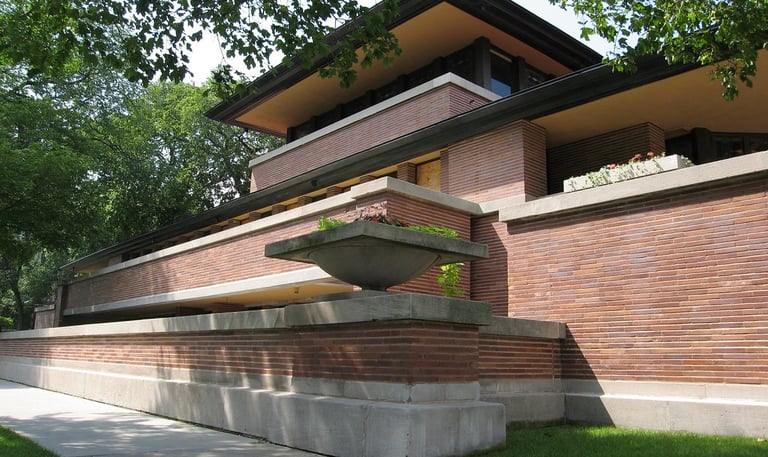Frank Lloyd Wright: A Master of Organic Architecture
In this blog post, we explore Wright's organic architecture philosophy, its influence on architecture and interior design, and some of his most iconic designs. He was a visionary architect who had a profound impact on the way we build and live today.
ARCHITECTURE


Frank Lloyd Wright: A Master of Organic Architecture
Introduction
Frank Lloyd Wright is widely regarded as one of the greatest American architects of all time. He is renowned for his organic architecture philosophy, which emphasized harmony between buildings and their natural surroundings. Wright's designs are characterized by their clean lines, geometric forms, and use of natural materials. He also pioneered the concept of open floor plans and the integration of indoor and outdoor living spaces.
Wright's Philosophy of Organic Architecture
Wright's organic architecture philosophy is based on the idea that buildings should be in harmony with their natural surroundings. He believed that architecture should be "organic" in the sense that it should grow out of the land and be in keeping with the local climate and culture. Wright's designs often feature natural materials such as wood, stone, and brick, and they are often integrated into the landscape in a way that minimizes their impact on the environment.
Wright's organic architecture philosophy is also based on the principle of unity. He believed that all elements of a building should work together to create a harmonious whole. This includes the exterior design, the interior design, and the surrounding landscape. Wright also believed that buildings should be functional and comfortable for the people who use them.
Wright's Iconic Designs
Wright designed over 1,000 buildings during his lifetime, many of which have become iconic landmarks. Some of his most famous designs include:
Fallingwater: This house is cantilevered over a waterfall in Mill Run, Pennsylvania. It is considered to be one of the greatest works of American architecture.
Guggenheim Museum: This museum in New York City is known for its unique spiral design. It is one of the most popular tourist destinations in the city.
Robie House: This house in Chicago is considered to be one of the earliest examples of Prairie School architecture. It is known for its flat roof, cantilevered overhangs, and geometric forms.
Unity Temple: This Unitarian Universalist church in Oak Park, Illinois, is considered to be one of Wright's most important early works. It is known for its simple, geometric design and its use of concrete.
Taliesin West: This winter home and studio in Scottsdale, Arizona, was Wright's home for much of his life. It is now a museum and Taliesin Architects, the firm that Wright founded, continues to operate from there.
Wright's Influence on Architecture and Interior Design
Wright's influence on architecture and interior design is immense. His organic architecture philosophy has inspired generations of architects, and his designs are still studied and admired today.
Wright's work has had a particularly significant impact on the way we design our homes. His focus on open floor plans and the integration of indoor and outdoor living spaces has shaped the way we live today. Wright's work has also influenced the use of natural materials and sustainable design practices in architecture and interior design.
Conclusion
Frank Lloyd Wright was a visionary architect who had a profound impact on the field of architecture and interior design. His organic architecture philosophy continues to inspire architects and designers today. Wright's work is a reminder that buildings can be in harmony with their natural surroundings and that they should be designed to be both functional and comfortable for the people who use them.
Additional Information About Frank Lloyd Wright
Frank Lloyd Wright was born in Richland Center, Wisconsin, in 1867. He began his architectural career in Chicago in the late 1880s. Wright's early work was influenced by the Prairie School of architecture, which emphasized simplicity and horizontality. Wright's designs soon began to evolve, and he developed his own unique style, which he called organic architecture.
Wright's work was not without its critics. Some people found his designs to be too radical and unconventional. However, Wright never wavered in his commitment to his principles. He continued to design and build innovative and groundbreaking buildings throughout his career.
Wright died in 1959 at the age of 91. He left behind a legacy of over 1,000 buildings, including some of the most iconic and influential examples of American architecture. Wright's work continues to inspire and amaze people all over the world.
Thank you for reading! If you're interested in learning more about architecture and interior design, be sure to visit our website and follow us on social media. By visiting our website, you'll gain access to valuable resources, including our coaching program, which is designed to equip you with the knowledge and skills to excel in your design career. You'll also be the first to know about new blog posts, industry news, and upcoming events. So don't wait – visit our website and follow us on social media today to take your design skills to the next level!
Other articles of your interest
Are Carbon Neutral Buildings Expensive?
Best Interior Design Tips to Decorate Your Home
10 Best Architecture Design Tips for Students and Professionals
10 Must-Have Skills for Modern Architects and Interior Designers



